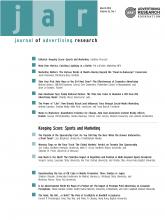Click on the PDF link for the complete article.
ABSTRACT
This study explored the collective impact of repetition and position on advertising effectiveness as evidenced through recognition and likeability of advertisements that were broadcast at different times in the Super Bowl. The findings indicate that brands advertised more in the first half and brands that appeared in both halves but shown more in one half than the other were better recognized than those equally promoted in both halves. Meanwhile, advertisements presented in both halves but repeated more in the second half were less favored than those evenly shown in both halves. The results support theories of repetition and primacy effects.
- © Copyright 2012 The ARF. All rights reserved.
ARF MEMBERS
If you are a member of the Advertising Research Foundation, you can access the content by logging in here
Log In
Pay Per Article - You may access this article (from the computer you are currently using) for 30 days for US$20.00
Regain Access - You can regain access to a recent Pay per Article purchase if your access period has not yet expired.





